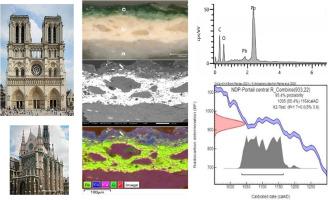Medieval polychromy from Parisian Gothic sculptures (1145–1250): Tracing stone preparation techniques by chemical analyses and radiocarbon dating of lead white
IF 3.3
2区 综合性期刊
0 ARCHAEOLOGY
引用次数: 0
Abstract
This study presents a comprehensive analysis of preparatory layers of polychrome decoration of the portals of three major Parisian Gothic monuments dating from the mid-twelfth through the mid-thirteenth centuries: Saint-Germain-des-Prés church, Notre-Dame cathedral and Paris Sainte-Chapelle. Through a multi-analytical approach combining microscopy, spectroscopy, X-Ray diffraction, and radiocarbon dating, we characterized the composition and chronology of the preparatory layers.
Microscopic and spectroscopic analyses reveal a consistent use of lead white as the primary component in preparatory layers across all monuments, with variations in minor materials. The Notre-Dame Last Judgment portal uniquely shows a two-layer system: a lead white base followed by yellow ochre, with evidence of environmental exposure between applications. The Sainte-Chapelle samples contain distinctive traces of minium mixed with lead white, while Saint-Germain-des-Prés and Notre-Dame's Sainte-Anne portal share similar compositions of lead white mixed with calcium carbonate and aluminosilicates.
Radiocarbon dating of lead white provides unprecedented chronological evidence. The Sainte-Anne portal samples date to 1016–1158 CE, confirming the reuse of 12th-century elements. The Last Judgment portal samples yield dates of 1035–1164 CE, while Sainte-Chapelle samples date to 1040–1163 CE. Although these dates represent lead white pigment synthesis rather than application, they raise questions about sophisticated material supply networks as well as storage practices in medieval times.
Thanks to the combination of analytical techniques implemented, this research has made it possible to identify different stone preparation techniques within the same building and the evidence of phased applications challenges previous assumptions about medieval workshop practices and construction site phases.

巴黎哥特式雕塑的中世纪多色(1145-1250):通过化学分析和放射性碳测定白铅的年代来追踪石头的制备技术
本研究全面分析了12世纪中期至13世纪中期三个主要的巴黎哥特式纪念碑:圣日耳曼教堂、圣母院大教堂和巴黎圣礼拜堂的入口彩绘装饰的准备层。通过显微、光谱学、x射线衍射和放射性碳定年等多种分析方法,我们对预备层的组成和年代进行了表征。显微和光谱分析显示,所有纪念碑的预备层都一致使用白铅作为主要成分,少量材料也有所不同。巴黎圣母院的最后审判门户独特地展示了一个双层系统:一个铅白色的基础,然后是黄赭石,在应用程序之间有环境暴露的证据。圣礼拜堂的样品中含有微量的铅和白铅的混合,而圣日耳曼-德-普莱姆斯和圣母院的圣安妮入口有相似的白铅混合碳酸钙和铝硅酸盐的成分。白铅的放射性碳定年法提供了前所未有的年代证据。圣安妮门的样本可以追溯到公元1016年至1158年,证实了12世纪元素的再利用。“最后审判”门户的样本产自公元1035年至1164年,而圣礼拜堂的样本产自公元1040年至1163年。虽然这些日期代表了铅白颜料的合成而不是应用,但它们提出了中世纪复杂的材料供应网络和储存实践的问题。由于实施了分析技术的结合,这项研究使得在同一建筑中识别不同的石材制备技术成为可能,阶段性应用的证据挑战了以前关于中世纪车间实践和建筑工地阶段的假设。
本文章由计算机程序翻译,如有差异,请以英文原文为准。
求助全文
约1分钟内获得全文
求助全文
来源期刊

Journal of Cultural Heritage
综合性期刊-材料科学:综合
CiteScore
6.80
自引率
9.70%
发文量
166
审稿时长
52 days
期刊介绍:
The Journal of Cultural Heritage publishes original papers which comprise previously unpublished data and present innovative methods concerning all aspects of science and technology of cultural heritage as well as interpretation and theoretical issues related to preservation.
 求助内容:
求助内容: 应助结果提醒方式:
应助结果提醒方式:


